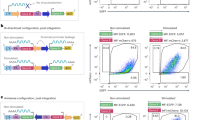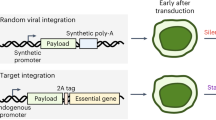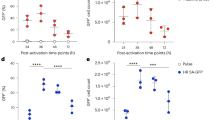Abstract
Retroviral vectors have become the primary tool for gene delivery into hematopoietic cells, including T lymphocytes. Lentiviral vectors offer an advantage over Moloney murine leukemia virus (MuLV) vectors because of their ability to translocate across an intact nuclear membrane and integrate into the genome of nonproliferating cells. We have recently demonstrated that a central strand displacement event, controlled by the central polypurine tract (cPPT) and the central termination sequence (CTS), results in the formation of a central DNA flap which acts as a cis-determinant of HIV-1 genome nuclear import. Here, we show that insertion of this DNA determinant in a classical lentiviral vector resulted in a significantly higher level of transduction in activated T cells (51 ± 12.7% versus 15 ± 1.4%). CD4+ and CD8+ T cells were transduced at equivalent levels. Importantly, freshly isolated T cells stimulated only during the 12-h transduction period could be efficiently transduced with this new flap-containing lentiviral vector, but not with the parental lentiviral vector nor an MuLV vector. Transgene expression in the flap-containing lentiviral vector, under the control of either an internal cytomegalovirus or the elongation factor-1 alpha (EF1α) promoter, was significant and expression remained elevated in resting T cells. Thus, this system allows stable expression of transgenes in T lymphocytes following a short ex vivo transduction protocol.
This is a preview of subscription content, access via your institution
Access options
Subscribe to this journal
Receive 6 print issues and online access
$259.00 per year
only $43.17 per issue
Buy this article
- Purchase on SpringerLink
- Instant access to full article PDF
Prices may be subject to local taxes which are calculated during checkout






Similar content being viewed by others
References
Plavec I et al. High transdominant RevM10 protein levels are required to inhibit HIV-1 replication in cell lines and primary T cells: implication for gene therapy of AIDS Gene Therapy 1997 4: 128–139
Roth T et al. Synthesis and biological activity of novel non-nucleoside inhibitors of HIV-1 reverse transcriptase. 2-Aryl-sub-stituted benzimidazoles J Med Chem 1997 40: 4199–4207
Hwu P et al. Lysis of ovarian cancer cells by human lymphocytes redirected with a chimeric gene composed of an antibody variable region and the Fc receptor gamma chain J Exp Med 1993 178: 361–366
Chinen J et al. Protection of primary human T cells from HIV infection by Trev: a transdominant fusion gene Hum Gene Ther 1997 8: 861–868
Blaese RM et al. T lymphocyte-directed gene therapy for ADA- SCID: initial trial results after 4 years Science 1995 270: 475–480
Bordignon C et al. Gene therapy in peripheral blood lymphocytes and bone marrow for ADA-immunodeficient patients Science 1995 270: 470–475
Kohn DB et al. T lymphocytes with a normal ADA gene accumulate after transplantation of transduced autologous umbilical cord blood CD34+ cells in ADA-deficient SCID neonates Nature Med 1998 4: 775–780
Mavilio F et al. Peripheral blood lymphocytes as target cells of retroviral vector-mediated gene transfer Blood 1994 83: 1988–1997
Bunnell BA et al. High-efficiency retroviral-mediated gene transfer into human and nonhuman primate peripheral blood lymphocytes Proc Natl Acad Sci USA 1995 92: 7739–7743
Rudoll T et al. High-efficiency retroviral vector mediated gene transfer into human peripheral blood CD4+ T lymphocytes Gene Therapy 1996 3: 695–705
Lam JS et al. Improved gene transfer into human lymphocytes using retroviruses with the gibbon ape leukemia virus envelope Hum Gene Ther 1996 7: 1415–1422
Pollok KE et al. High-efficiency gene transfer into normal and adenosine deaminase-deficient T lymphocytes is mediated by transduction on recombinant fibronectin fragments J Virol 1998 72: 4882–4892
Fehse B et al. Highly-efficient gene transfer with retroviral vectors into human T lymphocytes on fibronectin Br J Haematol 1998 102: 566–574
Dardalhon V et al. Green fluorescent protein as a selectable marker of fibronectin-facilitated retroviral gene transfer in primary human T lymphocytes Hum Gene Ther 1999 10: 5–14
Roe T et al. Integration of murine leukemia virus DNA depends on mitosis EMBO J 1993 12: 2099–2108
Miller DG, Adam MA, Miller AD . Gene transfer by retrovirus vectors occurs only in cells that are actively replicating at the time of infection Mol Cell Biol 1990 10: 4239–4242
Lewis PF, Emerman M . Passage through mitosis is required for oncoretroviruses, but not for the human immunodeficiency virus J Virol 1994 68: 510–516
Miyoshi H et al. Stable and efficient gene transfer into the retina using an HIV-based lentiviral vector Proc Natl Acad Sci USA 1997 94: 10319–10323
Naldini L et al. In vivo gene delivery and stable transduction of nondividing cells by a lentiviral vector Science 1996 272: 263–267
Poeschla E, Corbeau P, Wong-Staal F . Development of HIV vectors for anti-HIV gene therapy Proc Natl Acad Sci USA 1996 93: 11395–11399
Uchida N et al. HIV, but not murine leukemia virus, vectors mediate high efficiency gene transfer into freshly isolated G0/G1 human hematopoietic stem cells Proc Natl Acad Sci USA 1998 95: 11939–11944
Zufferey R et al. Multiply attenuated lentiviral vector achieves efficient gene delivery in vivo Nat Biotechnol 1997 15: 871–875
Reiser J et al. Transduction of nondividing cells using pseudotyped defective high-titer HIV type 1 particles Proc Natl Acad Sci USA 1996 93: 15266–15271
Unutmaz D et al. Cytokine signals are sufficient for HIV-1 infection of resting human T lymphocytes J Exp Med 1999 189: 1735–1746
Zack JA . The role of the cell cycle in HIV-1 infection Adv Exp Med Biol 1995 374: 27–31
Charneau P, Alizon M, Clavel F . A second origin of DNA plus-strand synthesis is required for optimal human immunodeficiency virus replication J Virol 1992 66: 2814–2820
Charneau P et al. HIV-1 reverse transcription. A termination step at the center of the genome J Mol Biol 1994 241: 651–662
Zennou V et al. HIV-1 genome nuclear import is mediated by a central DNA flap Cell 2000 101: 173–185
Sirven A et al. The HIV-1 central DNA flap is a crucial determinant for lentiviral vector nuclear import and gene transduction of human hematopoietic stem cells Blood 2000 96: 4103–4110
Follenzi A et al. Gene transfer by lentiviral vectors is limited by nuclear translocation and rescued by HIV-1 pol sequences Nat Genet 2000 25: 217–222
Uckert W et al. Efficient gene transfer into primary human CD8+ T lymphocytes by MuLV-10A1 retrovirus pseudotype Hum Gene Ther 2000 11: 1005–1014
Uetsuki T et al. Isolation and characterization of the human chromosomal gene for polypeptide chain elongation factor-1 alpha J Biol Chem 1989 264: 5791–5798
Quinn ER, Lum LG, Trevor KT . T cell activation modulates retrovirus-mediated gene expression Hum Gene Ther 1998 9: 1457–1467
Agarwal M et al. Scaffold attachment region-mediated enhancement of retroviral vector expression in primary T cells J Virol 1998 72: 3720–3728
Douglas J et al. Efficient transduction of human lymphocytes and CD34+ cells via human immunodeficiency virus-based gene transfer vectors Hum Gene Ther 1999 10: 935–945
Page KA, Landau NR, Littman DR . Construction and use of a human immunodeficiency virus vector for analysis of virus infectivity J Virol 1990 64: 5270–5276
Zufferey R et al. Self-inactivating lentiviral vector for safe and efficient in vivo gene delivery. Multiply attenuated lentiviral vector achieves efficient gene delivery in vivo J Virol 1998 72: 9873–9880
Korin YD, Zack JA . Progression to the G1b phase of the cell cycle is required for completion of human immunodeficiency virus type 1 reverse transcription in T cells J Virol 1998 72: 3161–3168
Case SS et al. Stable transduction of quiescent CD34(+)CD38(−) human hematopoietic cells by HIV-1-based lentiviral vectors Proc Natl Acad Sci USA 1999 96: 2988–2993
Wells AD, Gudmundsdottir H, Turka LA . Following the fate of individual T cells throughout activation and clonal expansion. Signals from T cell receptor and CD28 differentially regulate the induction and duration of a proliferative response J Clin Invest 1997 100: 3173–3183
Riley JL et al. Naive and memory CD4 T cells differ in their susceptibilities to human immunodeficiency virus type 1 infection following CD28 costimulation: implications for transmission and pathogenesis J Virol 1998 72: 8273–8280
Levine BL et al. CD28 ligands CD80 (B7–1) and CD86 (B7–2) induce long-term autocrine growth of CD4+ T cells and induce similar patterns of cytokine secretion in vitro Int Immunol 1995 7: 891–904
Costello E et al. Gene transfer into stimulated and unstimulated T lymphocytes by HIV-1-derived lentiviral vectors Gene Therapy 2000 7: 596–604
Kung SK, An DS, Chen IS . A murine leukemia virus (MuLV) long terminal repeat derived from rhesus macaques in the context of a lentivirus vector and MuLV gag sequence results in high-level gene expression in human T lymphocytes J Virol 2000 74: 3668–3681
Pollok KE et al. Costimulation of transduced T lymphocytes via T cell receptor–CD3 complex and CD28 leads to increased transcription of integrated retrovirus Hum Gene Ther 1999 10: 2221–2236
Yee JK et al. A general method for the generation of high-titer, pantropic retroviral vectors: highly efficient infection of primary hepatocytes Proc Natl Acad Sci USA 1994 91: 9564–9568
Dardalhon V et al. Highly efficient gene transfer in naive human T cells with a murine leukemia virus-based vector Blood 2000 96: 885–893
Moritz T, Patel VP, Williams DA . Bone marrow extracellular matrix molecules improve gene transfer into human hematopoietic cells via retroviral vectors J Clin Invest 1994 93: 1451–1457
Kimizuka F et al. Production and characterization of functional domains of human fibronectin expressed in Escherichia coli J Biochem 1991 110: 284–291
Acknowledgements
We are grateful to M Sitbon for critical insights during the course of this work. Dr Ikunoshin Kato and Setsuko Yoshimura of Takara Shuzo Co Ltd are generously acknowledged for providing the recombinant fibronectin fragment and for their continuing assistance. We are indebted to Drs C June, D Cantrell and S Nagata for generously providing reagents. Supported by grants from the ANRS and AFM (NT and PC), March of Dimes Grant No. 6.FY99-406 and ARC (NT).
Author information
Authors and Affiliations
Rights and permissions
About this article
Cite this article
Dardalhon, V., Herpers, B., Noraz, N. et al. Lentivirus-mediated gene transfer in primary T cells is enhanced by a central DNA flap. Gene Ther 8, 190–198 (2001). https://doi.org/10.1038/sj.gt.3301378
Received:
Accepted:
Published:
Issue Date:
DOI: https://doi.org/10.1038/sj.gt.3301378
Keywords
This article is cited by
-
Genetically encoding multiple functionalities into extracellular vesicles for the targeted delivery of biologics to T cells
Nature Biomedical Engineering (2023)
-
Lentiviral delivery of combinatorial CAR/CRISPRi circuit into human primary T cells is enhanced by TBK1/IKKɛ complex inhibitor BX795
Journal of Translational Medicine (2020)
-
Dynamic regulatory network controlling TH17 cell differentiation
Nature (2013)
-
Residual HIV-1 DNA Flap-independent nuclear import of cPPT/CTS double mutant viruses does not support spreading infection
Retrovirology (2011)
-
Advances in the Field of Lentivector-based Transduction of T and B Lymphocytes for Gene Therapy
Molecular Therapy (2010)



